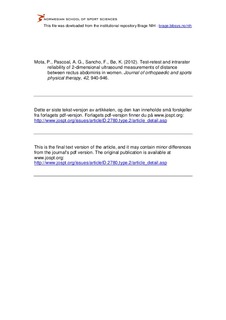| dc.contributor.author | Mota, Patricia | |
| dc.contributor.author | Pascoal, Augusto Gil | |
| dc.contributor.author | Sancho, Fatima | |
| dc.contributor.author | Bø, Kari | |
| dc.date.accessioned | 2013-01-31T07:54:14Z | |
| dc.date.accessioned | 2013-02-01T04:06:07Z | |
| dc.date.available | 2013-01-31T07:54:14Z | |
| dc.date.available | 2013-02-01T04:06:07Z | |
| dc.date.issued | 2012 | |
| dc.identifier | Seksjon for idrettsmedisinske fag / Department of Sports Medicine | |
| dc.identifier.citation | Journal of Orthopaedic & Sports Physical Therapy. 2012, 42, 940-946 | |
| dc.identifier.issn | 0190-6011 | |
| dc.identifier.uri | http://hdl.handle.net/11250/171104 | |
| dc.description | I Brage finner du siste tekst-versjon av artikkelen, og den kan inneholde ubetydelige forskjeller fra forlagets pdf-versjon. Forlagets pdf-versjon finner du på www.jospt.com: http://www.jospt.org/issues/articleID.2780,type.2/article_detail.asp / In Brage you'll find the final text version of the article, and it may contain insignificant differences from the journal's pdf version. The definitive version is available at www.jospt.com: http://www.jospt.org/issues/articleID.2780,type.2/article_detail.asp | |
| dc.description.abstract | STUDY DESIGN: Single-group test-retest reliability study. OBJECTIVES: To evaluate the test-retest intraobserver reliability of 2-dimensional ultrasound measurement of the distance between the rectus abdominis muscles, the interrectus distance (IRD). BACKGROUND: Diastasis recti is defined as the separation of the 2 rectus abdominis muscles, with a reported prevalence of between 30% and 70% in women during pregnancy and in the postpartum period. The condition is difficult to measure, and ultrasound imaging has been suggested as a useful method to quantify the diastasis. However, to date, no studies have investigated intratester or intertester reliability of ultrasound to measure the distance between the rectus abdominis muscles during rest and contraction. METHODS: Ultrasound images from the rectus abdominis were recorded in 24 healthy female volunteers at rest and under 2 conditions of abdominal contraction: abdominal crunch and drawing-in exercises. The probe was positioned at 2 locations: below and above the umbilicus. A blinded investigator measured the IRD offline from 2 different ultrasound images collected on 2 different days (test-retest). Additionally, reanalyses of the same ultrasound images were done on 2 separate occasions (intra-image). RESULTS: Test-retest measurements of IRD demonstrated good to very good reliability, with intraclass correlation coefficient values between 0.74 and 0.90. The only exception was for IRD measured 2 cm below the umbilicus during the abdominal crunch exercise, which had an intraclass correlation coefficient of 0.50. For intratester reliability of the same images, the intraclass correlation coefficient values were all above 0.90. CONCLUSION: Ultrasound imaging is a reliable method for measuring the IRD at rest and during abdominal crunch and drawing-in exercises. | |
| dc.language.iso | eng | |
| dc.publisher | APTA | |
| dc.subject | diastasis | |
| dc.subject | postpartum | |
| dc.subject | reliability | |
| dc.subject | ultrasonography | |
| dc.title | Test-retest and intrarater reliability of 2-dimensional ultrasound measurements of distance between rectus abdominis in women | |
| dc.type | Journal article | |
| dc.type | Peer reviewed | |
| dc.subject.nsi | VDP::Social science: 200::Social science in sports: 330::Other subjects within physical education: 339 | |
| dc.source.pagenumber | 940-946 | |
| dc.source.volume | 42 | |
| dc.source.journal | Journal of Orthopaedic & Sports Physical Therapy | |
| dc.source.issue | 11 | |
